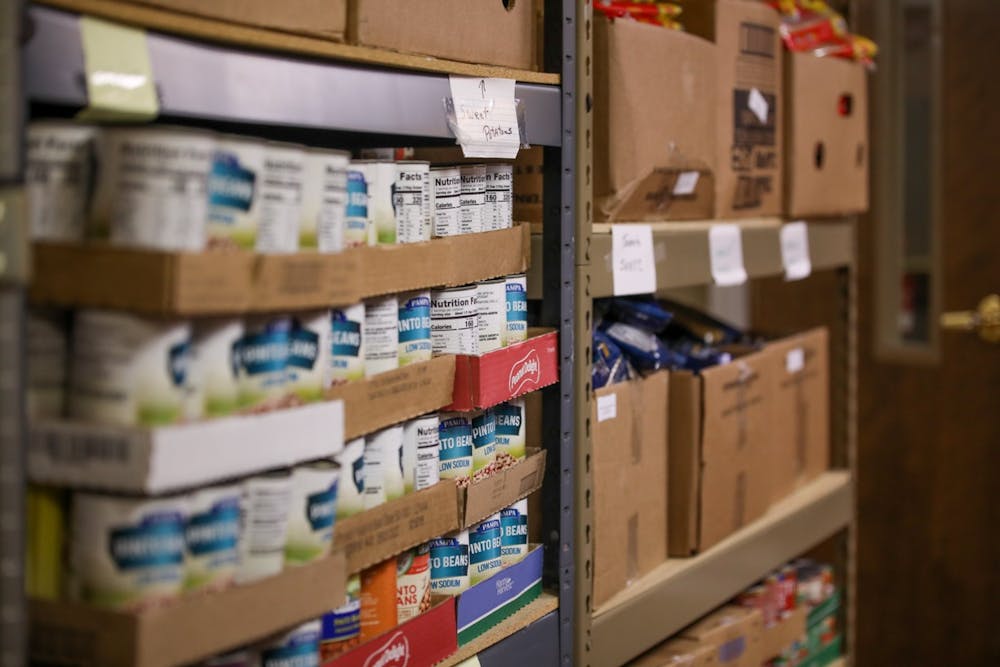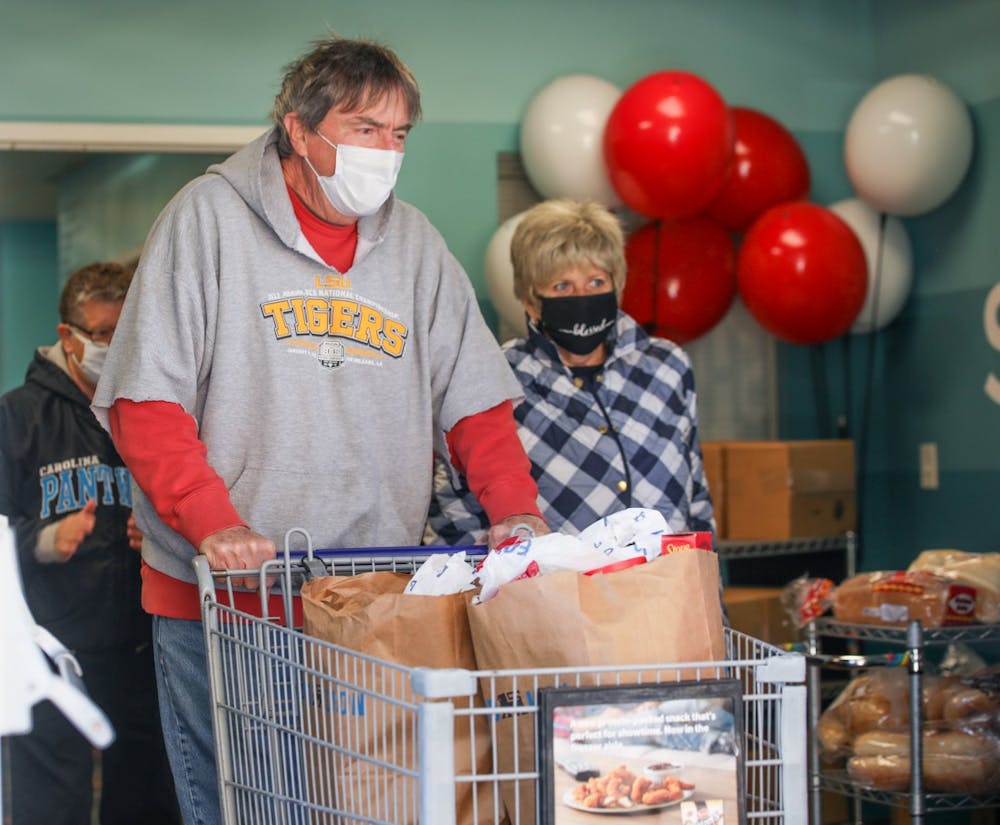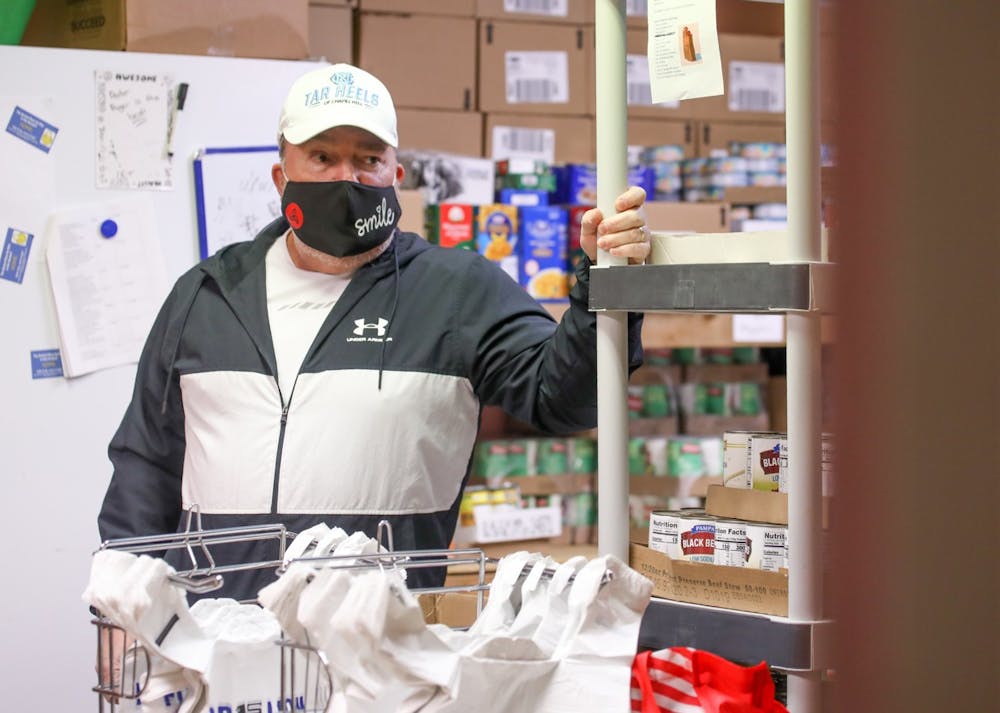March 2021 marks the one year anniversary of the pandemic, yet as it continues with food insecurity rates on the rise, many food banks and pantries are weary of the strain the past year has put on food resources and volunteers and staff. Food insecurity — the lack of access, at times, to sufficient amounts of food for a healthy life for all household members — has been an issue in North Carolina prior to the pandemic.
“As we get into this year, toward the end of the year and beyond, are we still gonna have the support that we’re going to need?” said Mike Darrow, executive director of Feeding the Carolinas. “We’re still gonna be feeding, literally feeding the Carolinas.”
North Carolina’s food insecurity rate was 14% of the population in 2018, according to Feeding America. Alamance County’s 2018 food insecurity rate was also at 14%; however, the county’s child food insecurity rate tops that at 19.7%. These figures compare to the overall national food insecurity rate of 11.5%, according to Feeding America.
More recent, pandemic-era data on food security has yet to be officially calculated, but projections and Feeding the Carolinas, a regional partner of Feeding America, estimate that food insecurity has definitely increased in North and South Carolina since the pandemic began.
“We’re seeing it in the lines of people, looking for food now. It used to be roughly one in seven adults, one in six kids, and now it’s more like one in five adults, and one in four kids are food insecure, meaning they don’t definitely know where their next meal is coming from,” Darrow said. “Food insecurity has definitely increased and will continue to for quite a while.”
Food insecurity is still being seen at the local level. Trinity Worship Center’s food pantry, a Burlington church, currently provides about 50 families with food per week, according to associate pastor Roger Barefoot. However, the number of families each week has been inconsistent and even decreased occasionally during the pandemic.
“I mean it was really crazy the fluctuation that we had in the people that came,” Barefoot said. “I think because people … were very weary about coming out.”
Where an individual lives, means to drive to food pantries, the cold weather months and just an overall lack of knowledge on available resources are other reasons why food insecure individuals may not be seeking out help despite the need, according to Marisol Biasetti, a Trinity Worship Center Volunteer.
“Why aren’t they not coming if there is such a shortage?” Biasetti said. “There may be a lack of knowledge in this case, not knowing that they can go to multiple places [pantries].”
LISTEN TO THIS STORY ON ENN RADIO:
Food banks and pantries have had to restructure their distribution methods centered around social distancing and limited-contact to operate safely during the pandemic. This has included implementing mobile drive-thru distribution of pre-packaged boxes of food or offering cold grab-and-go meals rather than the typical pre-pandemic hot plate dinners. The reliance on volunteers has also been reevaluated after the decline of volunteers during the pandemic’s peak.
“I felt like I always had staff either quarantined due to exposure or had gotten the virus themselves,” said Jason Fields, YMCA Feeds Program director. “It seemed like every week somebody couldn’t work for two weeks because they were in quarantine for one reason or another.”
Initial Impact of COVID-19 on Food Bank and Food Pantry Resources
Several food banks and local food pantries instantly felt the effects of the pandemic, whether that meant a surge in need amongst community members or being closed due to initial pandemic government mandates, which some church-affiliated food pantries like Trinity Worship Center experienced for a brief period.
“We closed down maybe for a bit. I think it was two months during the initial phase of the pandemic,” Barefoot said. “Instead of people coming into the church ... us interviewing them the way that we do, we always like to pray with them, as well, ask them if they have any needs or anything like that, now it is a drive-thru.”

Darrow said that Feeding the Carolinas and their partner agencies quickly experienced an increase in demand as the small business and hospitality industries took a dive, leaving already financially vulnerable and food insecure individuals at a higher-risk.
“Suddenly, [low income workers] were faced with the prospect of, ‘Do I buy food, or do I buy medicine, or do I pay my rent?’” Darrow said. “Instantly we saw increases in demand of 30 to 40% across the Carolinas of people needing food, and a good one-third of them had never been to a food bank before or had never needed one.”
Not only did the need for food skyrocket, but as food, non-perishables and toilet paper began flying off the shelves of grocery stores and retailers, little resources were left to be donated to food banks and pantries.
Trinity Worship Center Food Pantry receives much of their donations from the local Walmart and BJ’s Wholesale Club. Since the pandemic began, donations have been inconsistent, fluctuating between a maximum of 1500 and a minimum of 300 pounds of food, with one family-bag containing about 45 pounds of food, according to Barefoot and Trinity’s food pantry coordinator, Joan Barnes.
“At first whenever COVID was real new...the most difficult thing was actually the picking up of the food from vendors, because there was so much caution in people not being around each other,” Barefoot said.
With a lack of donations and ultimately empty shelves, the food supply for many food banks across the Carolinas became unsteady, and replenishment was not always cheap or easy to come by.
“The lead times for purchasing food went from a few days to six to eight weeks to get food in,” Darrow said. “The average [Feeding the Carolinas] food bank was spending about $82,000 a month purchasing food, and it leaped up to a million dollars a month.”
The decline in volunteers was another obstacle many food banks and pantries faced during the height of the pandemic. The majority of volunteers at these food resources centers are retired and elder individuals; therefore, in the higher-risk category for COVID-19.
For those who were still able and willing to volunteer, Darrow said that determining how to safely use volunteers and adhere to social distancing was another challenge.
In September 2020, more than 170 members of the North Carolina National Guard were activated to help with sorting, packing and distributing food due to the limited volunteer base. Guard members worked with the Food Bank of Central and Eastern North Carolina and helped distribute over 6.2 million food bank meals since the pandemic began.
However, not all food pantries experienced a shortage of volunteers. Volunteers of the Trinity Worship Center Food Pantry said they were never afraid of volunteering as their religious values guided them while volunteering amidst the pandemic.
“Faith over fear,” said Cindy Taylor, a Trinity Worship Center volunteer.
School Closures Impacting Food Insecure Kids
The effects of the pandemic differed for after-school feeding services such as YMCA Feeds, as many of these services were disrupted and some shut down due to the almost year-long closure of K-12 public schools. As a result, YMCA Feeds program director Jason Fields said that YMCA Feeding Program lost five of their feeding sites since they took place in schools.
Under the Child and Adult Food Program, a federal program that provides reimbursements for nutritious meals and snacks that are provided to eligible children and adults in child or adult day care centers or after-school care programs, the YMCA Feeding Program was serving nearly 450 meals per day during normal school sessions pre-pandemic, but has now decreased to about 175 meals per day.
“Some of those kids, because you feed them every day, you’d get a relationship with those kids,” Fields said. “Then suddenly, the rug was just pulled out from underneath of us where we were not allowed to go to those sites anymore.”

The Alamance-Burlington School System started a grab-and-go meal program, as well as a mobile meal program where ABSS buses went to low-income neighborhoods to distribute meals and provided a list of other food service resources.
But in the summer months of 2020, food service operations were disrupted once again since virtual school was no longer in session. The Summer Food Service Program, which is federally-funded and state-administered, released several waivers that made providing nutritious meals for kids in low-income areas easier amidst the pandemic.
Fields said that some of these waivers included a milk requirement waiver — traditionally, milk was a required item of the provided meal, but there was a milk shortage during the pandemic — an enrichment activity waiver and a congregate eating waiver enabling kids to grab the meals and go, no questions asked.
It was during this three-month period that Fields said he felt they were “battling hunger.” According to Fields, they would hand out hundreds of meals in 20 minutes.
“Those kids were starving as soon as we pulled in ... kids would just swarm the van out of those public housing units — they knew that that was good, healthy food,” Fields said. “Kids would grab that bag, they would take five steps away from the van and sit down right on the curb … beside each other and eat it as quickly as they could.”
But some parents and families were not willing to risk that limited amount of contact to obtain food resource services, which is fear Fields says still persists today with the recent opening of five virtual learning centers that YMCA Feeds Program serves.
“Families don’t feel comfortable sending their kids to [virtual learning sites] because of the risk of exposure … so people are having to gauge whether they want to take a little bit of risk in order to get the services that are best for their family, or just not take any risk at all,” Fields said.
Despite site closures and fear amongst those in need, YMCA Feeding Programs has served about 80,000 meals total over the past year of the pandemic.
Pushing past the one year mark
The food bank system is finally getting back on their feet after enduring a year of high-demand, inconsistent food supply and volunteer and staffing. But as the pandemic pushes on, with food insecurity rates on the rise, food banks acknowledge that they too must push on.
“That’s one of the biggest things I worry about is the staff fatigue, cause they’ve been going literally nonstop for a year,” Darrow said.
However, morale amongst volunteers at Trinity Worship Center’s pantry has intensified, not declined, Pastor Barefoot said, since many love helping their community members in need and find it rewarding.
“When we were giving out turkeys and meat, a woman said ‘Oh, praise God we got meat’ and I thought to myself, ‘How sad, how long have they not had meat?” Taylor said.
Another stress placed upon the food bank and pantry system is the flow of donations.
“We do worry about donor fatigue … As we ease out of this, are people’s attention gonna shift elsewhere while we still need the support?” Darrow said. “Just how long can this very stressed network of food banks continue on?”
Even for food programs that receive federal aid such as the YMCA Feeding Program are also weary of fatigue in the near future.
“We’ve been struggling through this for a long time and morale is down at times, but then you just have to keep the big picture in mind that there are hungry kids out there,” Fields said. “We have to keep trudging through to make sure that we get the food to them.”
Darrow predicts North and South Carolina’s network of food banks will likely continue to endure the impacts of the pandemic into 2022.
If there is any silver lining of the pandemic, it has exposed many of issues that exist within the food system and the states’ food insecurity levels, according to Darrow. Now that these challenges are at the forefront, solutions can be made to address these issues in the future.


